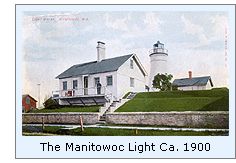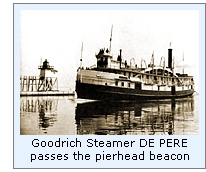|
Historical
Information
The brick tower stood 12' in diameter at the foundation and tapered to a diameter of 6' 6" immediately beneath the gallery. To accommodate these tapered walls while maintaining a basically cylindrical inner core for the stone stairs which wound their way around the tower's inner walls, the brick was laid so that it decreased in thickness from 3' 1" at the foundation to 1' 9" at the top. A circular stone floor was erected atop the tower, and an octagonal cast iron lantern with fifteen 11" by 9" plate glass panes on each side . installed at its center and capped with a copper roof and ventilator. Within the lantern, eleven Winslow Lewis patent lamps were installed, and equipped with 14" reflectors to exhibit a fixed white characteristic. All told, the structure stood 30 feet from the foundation to the lantern ball, and by virtue of the tower's location atop a slight bluff, boasted a focal plane of 63 feet.
During his visit to the station in 1850, Henry B Miller, the inspector for the Northwestern Lakes reported that other than finding the tower needing a coat of whitewash for which he authorized an expenditure of $15.00, both the station and the conduct of its keeper were good. The number of patent lamps in the lantern was reduced to six at some time thereafter in order to reduce operating costs. Such tight fiscal control in the face of maritime needs typified the administration of the Lighthouse Service under Stephen Pleasonton, and with the creation of the Lighthouse Board in 1853, one of the first issues of business for the new Board was a system-wide upgrading of the feeble and ubiquitous Lewis lamps to the infinitely superior French Fresnel-style lenses. To this end, the Lewis lamps at Manitowoc were removed and replaced by a fixed white Sixth Order Fresnel lens in 1856. Two years later, a work crew arrived at the station and replaced the dwelling floors, which had been found to be in poor condition during the previous year's inspection. The characteristic of the light was changed to fixed white varied by a white flash in 1859 with a visibility range of eleven miles in clear weather. For the next decade, little mention is made of the station beyond appearing in annual reports as being "fairly old, but in good condition" and only routine maintenance being performed on a periodic basis.
With the extension of the North pier,
and the relocation of the pierhead beacon, it was determined that the
old main light no longer served as a guide into the harbor, and the
decision was made to discontinue the old light, and thus the lens was
removed from the tower at the opening of the 1877 navigation season and
the Manitowoc Light ceased to appear on subsequent Great Lakes Light
Lists. While the old station no longer served any purpose as an aid to
navigation, it continued to serve as the primary dwelling for the keeper
of the Pierhead Light. |
 A number of memorials for harbor
improvements were presented before the House of Representatives and the
Senate on their behalf, and convinced that Manitowoc would be a
"going concern," federal funding for the establishment of a
lighthouse on the north shore of the river was made available, and a
work crew arrived in Manitowoc to begin construction in 1839.
A number of memorials for harbor
improvements were presented before the House of Representatives and the
Senate on their behalf, and convinced that Manitowoc would be a
"going concern," federal funding for the establishment of a
lighthouse on the north shore of the river was made available, and a
work crew arrived in Manitowoc to begin construction in 1839. The 1 ½ - story brick dwelling stood
34 by 20 feet in plan and contained a kitchen and parlor on the first
floor and two bedrooms and a closet on the second floor. A short covered
way led from the dwelling to the tower, and provided the keeper with
access to the light without having to go outside during inclement
weather, and a storage area for oil for the Lewis lamps. To render the
station visible during daylight hours, both tower and dwelling were
coated with whitewash, while the lantern was painted deep black.
The 1 ½ - story brick dwelling stood
34 by 20 feet in plan and contained a kitchen and parlor on the first
floor and two bedrooms and a closet on the second floor. A short covered
way led from the dwelling to the tower, and provided the keeper with
access to the light without having to go outside during inclement
weather, and a storage area for oil for the Lewis lamps. To render the
station visible during daylight hours, both tower and dwelling were
coated with whitewash, while the lantern was painted deep black. With the erection of the new Manitowoc
North Pierhead beacon in 1873, the Sixth Order lens was removed from the
main light and relocated to the new beacon, where it was equipped with a
red glass chimney to impart a fixed red characteristic, and a
With the erection of the new Manitowoc
North Pierhead beacon in 1873, the Sixth Order lens was removed from the
main light and relocated to the new beacon, where it was equipped with a
red glass chimney to impart a fixed red characteristic, and a